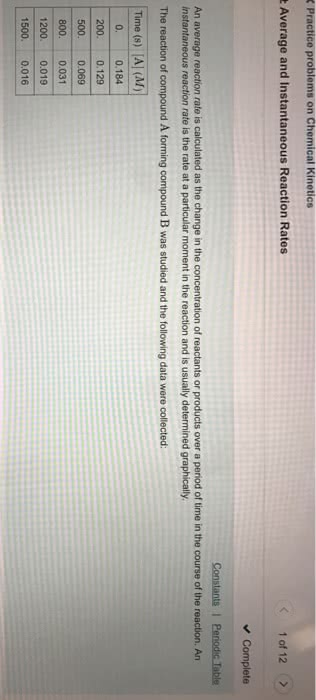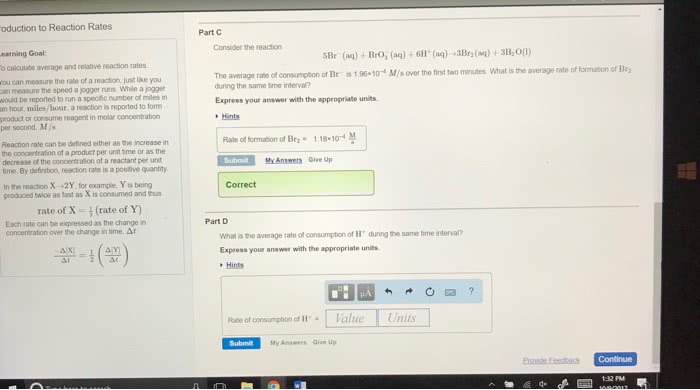CHEM10007 Lecture Notes - Lecture 21: Chemical Kinetics, Reaction Rate, Negative Number

LECTURE 21
REACTION RATES & CHEMICAL KINETICS
CHAPTER 13 - REACTION KINETICS
13.1 REACTION RATES
•Chemical kinetics can help us understand why reactions proceed in a particular way. It is the
study of the rates of chemical reactions; the rates of change of the concentrations of reactants and
products in a chemical reaction.
•We usually talk about the rate of consumption of a reactant and the rate of formation of a
product.
•We can determine the rate of consumption of reactant A and the rate of formation of product B
by measuring the concentrations of A and B at two different times, t1 (early in the reaction) and
t2 (later in the reaction).
rate of = -(concentration of A at time t2 - concentration of A at time t1)
consumption of A (t2 - t2)
= -Δ[A]
Δt
rate of = concentration of B at time t2 - concentration of B at time t1
formation of B t2 - t2
= Δ[B]
Δt
•Rates of consumption and formation are always reported as a positive value irrespective of
whether something increases or decreases in concentration. They tell us how fast or slow a
reaction is.
•The average rate of consumption or formation is the rate of a reaction over a particular time
period.
•The initial rate of consumption of formation is the rate of the reaction at the beginning of the
reaction, at time t = 0.
•The rate of change of concentration at a particular time is called the instantaneous rate of change
of concentration, and is the rate of change of concentration of a reactant pr product in a chemical
reaction at a particular time.
rate of = -(slope of tangent) = -d(concentration) = -d[A]
consumption of A d(time) dt
rate of = -(slope of tangent) = d(concentration) = d[B]
formation of B d(time) dt
•d and Δ are the same thing.
•The rate of a reaction has the unit concentration per unit time, or concentration time-1, which is
usually mol L-1s-1.
•Technically rates cannot be negative. If you do get a negative number, it means that the number is
the rate of the reactant/product being consumed, not formed.
•The rates of consumption of reactants and formation of products in a particular reaction are not
necessarily the same; it depends on the stoichiometry. Therefore we have to define the rate of

reaction whose value is the same regardless of whether we are monitoring rates of consumption of
reactants or rates of formation of products.
•For the general reaction:
•Aa + bB = cC + dD, where a, b, c, d are the stoichiometric coefficients of the reactants A and B
and the products C and D, we define the rate of reaction as:
13.2 FACTORS THAT AFFECT REACTION RATES
•There are 5 principle factors that influence reaction rates.
CHEMICAL NATURE OF THE REACTANTS
•During reactions, bonds break and new bonds form, therefore the most fundamental differences
between reaction rates lie in the reactants themselves, in the inherent tendencies of their atoms,
molecules or ions to undergo bond breaking and/or bond making processes.
•Some reactants are fast by nature and others are slow.
PHYSICAL NATURE OF THE REACTANTS (INCREASING SURFACE AREA)
•Most reactions involve two or more reactants whose constituent ions, atoms or molecules must
collide for the reaction to occur, which is why reactions are rarely carried out in the solid state
but often occur in liquid solutions or in the gas phase, as in these two states, the reactants are
easily able to intermingle and their constituent ions, atoms or molecules are able to collide easily.
•A homogenous reaction is a chemical reaction in which all participating species are in the same
phase.
•A heterogenous reaction is a reaction in which not all of the chemical species are in the same
phase. In heterogenous reactions, the reactants are only able to meet at the interface between the
phases, so the area of contact between the phases affects the reaction rate. This area is controlled
by the sizes of the particles of the reactant constituents.
•By pulverizing a solid, the TSA can be significantly increased, maximising contact between the
atoms, ions or molecules in the solid state with those in a different phase.
•Eg. It is common to crush a pill or tablet into powder to increase absorption rates, and
conversely, to decrease absorption rates, drug tablets are sometimes coated with wax or with a
water insoluble substance to reduce contact.
CONCENTRATIONS OF THE REACTANTS
•The rates of both homogenous and heterogenous reactions are affected by the concentrations of
the reactants.
•Eg. Wood burns fairly quickly in air but much more rapidly in pure oxygen.
TEMPERATURE OF THE SYSTEM
•Almost all chemical reactions occur faster at higher temperatures.
•Eg. Milk doesn’t spoil as quickly when cold, it takes longer to cook an egg at 80C than 100C.
Document Summary
13. 1 reaction rates: chemical kinetics can help us understand why reactions proceed in a particular way. T rate of = concentration of b at time t2 - concentration of b at time t1 formation of b t2 - t2. T: rates of consumption and formation are always reported as a positive value irrespective of whether something increases or decreases in concentration. 13. 2 factors that affect reaction rates: there are 5 principle factors that influence reaction rates. In heterogenous reactions, the reactants are only able to meet at the interface between the phases, so the area of contact between the phases affects the reaction rate. It is common to crush a pill or tablet into powder to increase absorption rates, and conversely, to decrease absorption rates, drug tablets are sometimes coated with wax or with a water insoluble substance to reduce contact.



